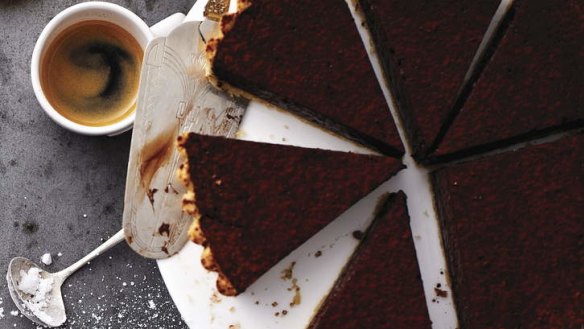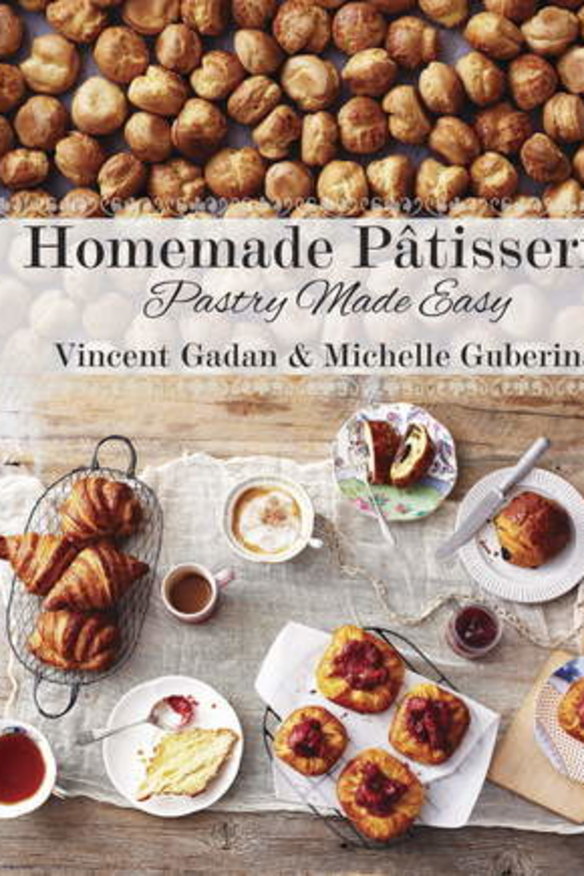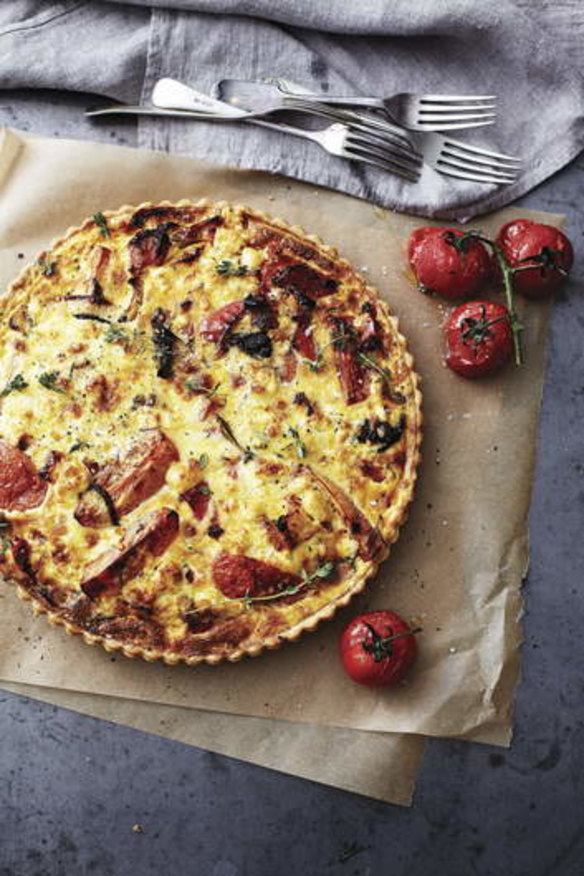Homemade Patisserie
<i>Homemade Patisserie</i>, by Vincent Gadan and Michelle Guberina, New Holland, $45.

For: The homemade-pastry-phobe.
French-import Vincent Gadan has worked in plenty of Michelin-starred restaurants and now helps run Sydney’s Patisse Cooking School with co-writer Michelle Guberina. The best thing about this book? Not Gadan’s touching tribute to ‘‘all the ladies out there’’ but the great step-by-step guides (with photos) to pie dough, choux and everything in between.
Recipe extract:
Baked chocolate tart
A delicious tart that will be a crowd pleaser and so easy to prepare.
Serves 6 to 8
Equipment
Mixing bowl, 8in (20cm)
Knife
Plastic wrap
Tart mould, 20cm x 4cm deep
Rolling pin
Baking weights
Saucepan, 5cm
Ingredients
For tart base
Butter, for greasing
Flour, for dusting
1 quantity (840g) biscuit dough (see recipe below)
For chocolate filling
180ml pouring cream
120ml milk
300g dark chocolate (70 per cent), chopped
2 eggs (50–55g each), lightly beaten
Method
1. Prepare the tart base
Prepare the tart mould by brushing inside with softened butter, dust with flour and shake off any excess - this will ensure the dough doesn’t stick to the mould after baking.
Lightly flour a clean surface on your kitchen bench, remove the plastic wrap from the dough and, using a rolling pin, roll the dough to a 5mm thickness. Using a rolling pin, gently wrap the dough around the rolling pin, then slowly unwind the dough over the mould.
Starting from the centre, press in the dough lightly with your fingers, working your way around the base and then up the sides. Take the rolling pin and roll over the top of the mould - this will cut the top edges, giving you a clean finish. Rest the dough in the refrigerator for 20 minutes.
Preheat the oven to 170C (Gas Mark 3). Prepare the tart base with baking weights (see below). Bake for about 10–15 minutes. Allow to cool.
2. Prepare the chocolate filling
In a saucepan, bring the cream and milk to the boil then add the chopped chocolate. Slowly add the beaten eggs and continue mixing until smooth.
3. Assemble, bake and serve
Pour the chocolate filling into the prebaked chocolate tart base. Bake in the oven at 100C (Gas Mark 1/2) for 25–30 minutes. Remove when the centre is still wobbly and place in the refrigerator to set for 1 hour.
Serve chilled or at room temperature.
Biscuit dough

This biscuit dough has a higher butter content than sweet dough so it is ideal for cookies or biscuits.
Makes 840g
Equipment
Baking weights
Mixing bowl, 20cm
Grater
Plastic wrap
Small knife for scraping vanilla
Ingredients
375g all-purpose/plain flour
10g almond meal
220g unsalted butter, cold, diced 5mm
grated zest of 1/2 orange
1/2 vanilla bean, cut lengthways, scraped
2 pinches table salt
8g baking powder
150g pure confectioners’ icing sugar
2 eggs (50–55g each)
Method
1. Place flour, almond meal and cold butter into a mixing bowl and rub the ingredients between your hands until it forms a sandy texture.
2. Add the grated zest, vanilla seeds, salt, baking powder, sugar and whole eggs, then mix with one hand to make a dough ball. Mix for 2 minutes until all combined.
3. Flatten the dough into a rectangle. Wrap the dough in plastic wrap and refrigerate for at least 20 minutes before using. Remove from the refrigerator, set on the bench and cut according to the recipe.
4. Prepare the dough with baking weights (see below) and bake the dough for 10–15 minutes. The dough can be stored in the refrigerator for up to 3 days or frozen for 1 month.
Tips and tricks
Using almond meal gives a more biscuit-like texture and taste—if you have nut allergies, replace the almond meal with flour. Any flavour or spice can be used instead of zest— try cinnamon, cardamom or ground coffee.
Dough pre-baking and weights
To prebake, we use something surprisingly practical - foil filled with weights, as it won’t break or put pressure on dough when applied. Here’s how it works - once the pastry has been placed inside its mould, unroll some foil over the pastry, then fill the foil with weights such as rice, lentils or beans. You can also buy proper baking weights which can be purchased in specialty cake or hospitality stores. This prevents the dough from rising and losing its shape. After prebaking, always remember to remove the weights, then proceed to the next step.

Provincial quiche
This quiche always features delicious ripe tomatoes conjuring aromas from Provence in the South of France.
Serves 5 to 6
Equipment
Tart mould, 27cm diameter x 3cm deep
Baking tray, 8in (20cm) diameter
Roasting tray 8in (20cm)
Rolling pin
Plastic wrap
Baking weights
Mixing bowls
Whisk
Knife
Chopping board
Ingredients
1 large red capsicum, seeded and diced (2cm)
1 large yellow capsicum, seeded and diced (2cm)
1 zucchini, medium, cut in half lengthways and sliced finely
1 1/2 tablespoons extra virgin olive oil
2 sprigs fresh thyme, chopped
2 garlic cloves, chopped finely
4 Roma tomatoes, quartered
salt and cracked pepper to taste
3 eggs (50–55g each)
120ml pouring cream
120ml milk
100g feta, drained and chopped
Quiche base
Softened butter for greasing
Flour for dusting
3/4 quantity (300g) pie dough (see recipe below)
Tips and tricks
You can vary the types of vegetables used; however, do not use too many vegetables with a high water content as they release too much liquid and the quiche will not set.
Method
1. Prepare the quiche base
Prepare the tart mould by brushing inside with softened butter, dust with flour and shake off any excess. This will ensure the dough doesn’t stick to the mould after baking.
Lightly flour a clean surface on your kitchen bench, remove plastic wrap from the dough and place the dough in the centre of the work area.
Using a rolling pin, roll out the dough into a 30cm diameter circle. Roll onto a rolling pin and then slowly unwind the dough over the mould. Starting from the centre, press in the dough lightly with your fingers, working your way around the base and then up the sides, making sure the bottom edge is in contact with the mould.
Take the rolling pin and roll over the top of the mould—this will cut the top edges, giving you a clean finish. Rest in refrigerator for 20 minutes before baking.
Preheat the oven to 175C (Gas Mark 4). Prepare the tart base with baking weights (see pre-baking notes in chcolate tart recipe, above).
Bake the base for 30–40 minutes then remove from the oven and set aside.
2. Prepare the filling
Place the capsicums and zucchini in a roasting tray and drizzle with olive oil. Scatter the thyme and garlic over the top then roast in the oven at 175°C (Gas Mark 4) for 15 minutes.
Add the tomato and roast for another 10 minutes. Season to taste with salt and pepper, and set aside to cool.
In a mixing bowl, whisk the eggs, cream, milk and salt until combined.
3. Assemble, bake and serve
Scatter the roasted vegetables over the base of the prebaked mould, then sprinkle with the feta. Place the filled quiche base onto a baking tray and pour in the filling mixture to the rim — making sure that it doesn’t overflow—then season with cracked pepper.
Bake in the oven at 170°C for 25–30 minutes. When the quiche is ready, it should be slightly wobbly in the centre. Let it rest for 5–10 minutes, then remove from mould gently — serve with green leaves and tomato relish.
Pie dough
This versatile dough is a crumbly pastry used for mainly savoury items such as pies and quiches. It can also be used for sweet desserts such as Flan Parisien.
Makes 460g
Equipment
Mixing bowl, 20cm diameter
Rolling pin
Baking tray
Plastic wrap
Baking weights
Ingredients
180g unsalted butter, cold, diced 1.5cm cubes
230g all-purpose/plain flour
2 pinches table salt
50ml water
Tips and tricks
If making the dough with an electric mixer, use a paddle attachment and stop regularly to check that the butter is not overmixed.
1. In a bowl, rub the butter into the flour and salt until it forms a crumbly texture—there should still be partial chunks of butter in the dry mix.
2. Add the water and mix until just combined—the butter should still be seen in the dough like a marbled effect. Do not overwork or you will lose the crumbly texture and layering effect of the butter.
3. Flatten the dough into a rectangle approximately 1cm thick, wrap it in plastic wrap and rest the dough in the refrigerator for 20 minutes.
4. Lightly flour a clean surface on your kitchen bench. Take out the dough from the refrigerator, remove the plastic wrap and, using a rolling pin, roll out to a 3mm thickness—lift up the dough from the bench occasionally to relax it, and re-flour if needed to ensure the dough is not sticking to the bench. Then cut to size according to the recipe and place in a tart mould.
5. Preheat the oven to 170°C (Gas Mark 3). Prepare the tart base with baking weights (see notes on prebaking). Bake for about 20–25 minutes. The dough can be stored in the refrigerator for up to 3 days or frozen for 1 month.
The best recipes from Australia's leading chefs straight to your inbox.
Sign up